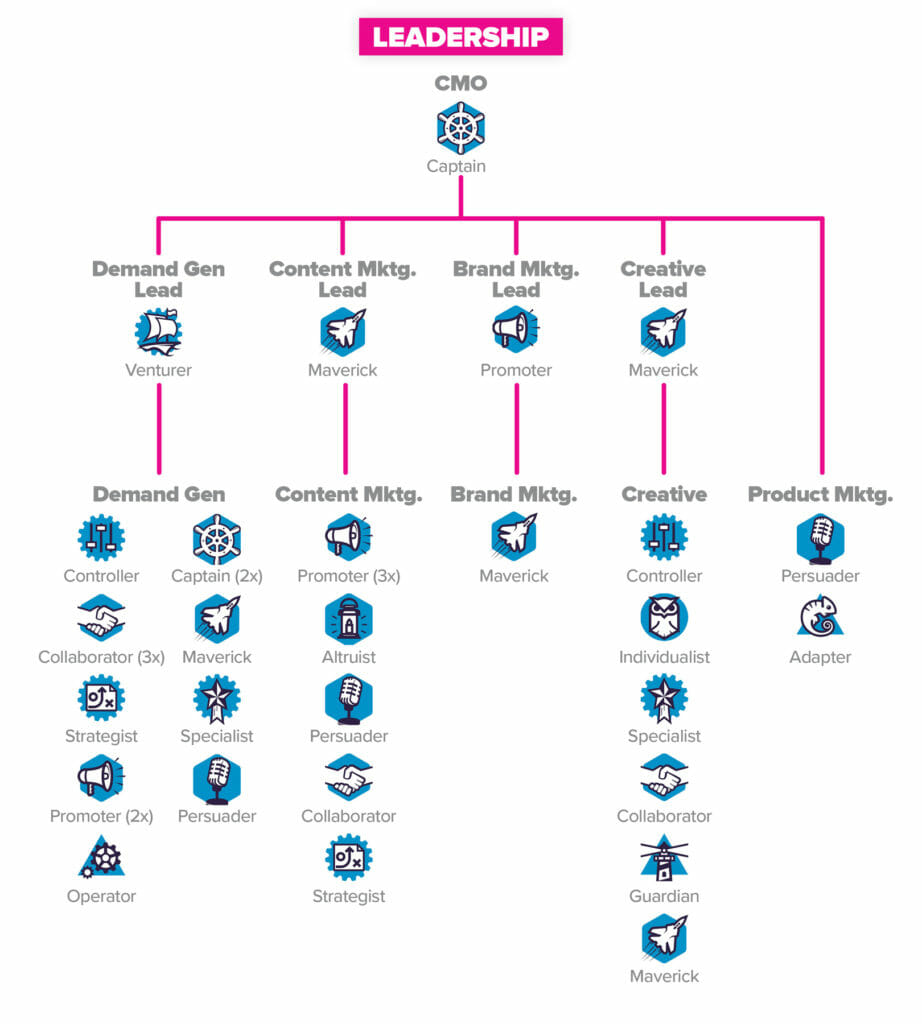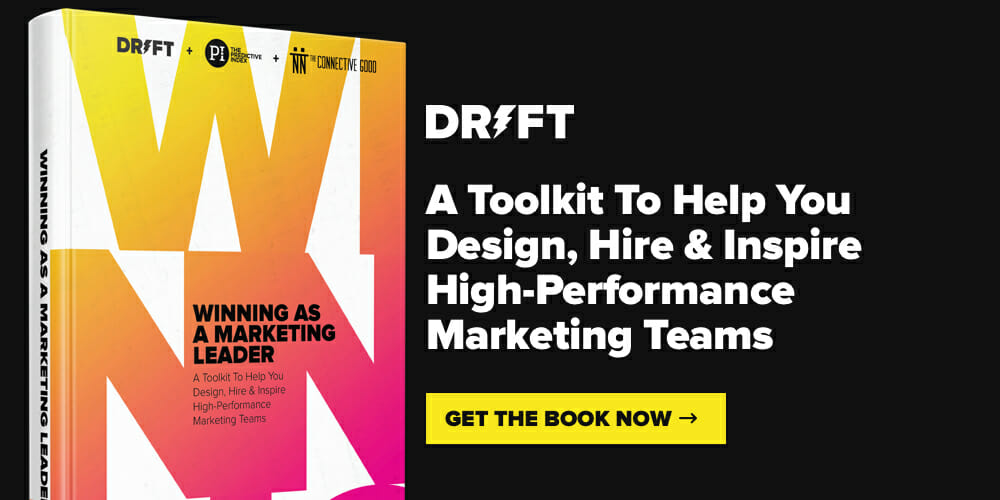I joined Drift back in October 2019. Even before day one, I knew Drift did things a little differently than your run-of-the-mill tech start-up.
After agreeing to come in for an interview, I got a follow-up email from our VP of Content & Community, Mark Kilens, asking if I could take The Predictive Index Behavioral Assessment prior to the meeting:
“We ask all of our candidates to take the Behavioral Assessment prior to coming in for an interview. We use the BA to help with coaching, interviewing, better team collaboration/communication, etc. It should only take you five to 10 minutes to fill out.”
Needless to say, my survey results didn’t scare them away. And, if my writing style didn’t give it away already—yes, I am a Promoter.

Unbeknownst to me, a few weeks into starting at Drift, I would run into The Predictive Index again. Not as a survey, but as a partnership.
This month, I’m excited to say that partnership is on full display with the release of Winning As a Marketing Leader: A Toolkit To Help You Design, Hire & Inspire High-Performance Marketing Teams. It’s an e-book for marketing executives on how to build high-performance marketing teams using PI’s talent optimization framework.
In the e-book, we offer a glimpse of the PI Reference Profiles that make up the Drift Marketing team.
Below, we’ll share some content from the book, look at how Drift uses this PI data to create high-performance teams, and discuss the personalities that make up the current Drift Marketing team. We’ll also explore how marketing leaders can use talent optimization within their own department.
How we use The Predictive Index at Drift
Prior to hiring a candidate, Drift asks interviewees to take a PI assessment. The assessment is simple enough and only two pages in length. On both pages, you’re given the same list of words.
The directions on the first page ask: “Please read the words in the list below and check those that you feel describe the way you are expected to act by others.”
The second page then instructs: “Continue by reading the words in the list below, now checking those that you yourself believe really describe you.” It shows the same list of words. Using the answers from both these pages, assessment takers are provided a behavioral pattern and assigned one of 17 possible Reference Profiles.
What’s the difference between a behavioral pattern and a Reference Profile? You can think of your Reference Profile as your zip code and your behavioral pattern as your address. That is, many individuals share the same Reference Profile, but your behavioral pattern is unique to you.
Considering how, as PI puts it, I’m an “uninhibited and persuasive extravert,” here’s a breakdown of what I’m all about:
Promoters are generally informal, highly social, and collaborative. You can view my behavioral pattern below.

The points labeled A, B, C, and D relate to four key workplace behaviors on which PI bases the Behavioral Assessment. These are:
- Dominance (A): the drive to influence people or events
- Extraversion (B): the drive for social interaction
- Patience (C): the drive for stability and consistency
- Formality (D): the drive to conform to rules and structure
So, why would knowing this type of information be important for management and team members at Drift? Here are a few reasons:
- It can help explain how to interact with different teammates.
- It can reveal what types of behavioral drives the marketing team lacks.
- It can provide insight into manager/employee relationships.
Now that you know a little about me and how we use The Predictive Index here at Drift, let’s look at the other Reference Profiles that fuel Drift’s marketing.
The PI Reference Profiles that make up Drift’s marketing team
Would you believe I’m one of a number of Promoters on the Drift marketing team? In fact, 50% of our Content & Community team are Promoters.
This makes a lot of sense: The job often requires creativity and community-building. But the content team is just one area of our larger marketing organization. As part of Winning As A Marketing Leader, we provided a snapshot of the behavioral profiles that make up our marketing team.

Looking at the above breakdown, it’s easy to see the dynamics of our team.
At the head, we see our CMO, Tricia Gellman, who is a Captain. Captains are often defined as self-starters and innovators. Likewise, CMOs need to set the direction of their team and often do so with little to no direction.
Our content and creative leaders are both Mavericks. Their jobs require the type of creativity and vision associated with the Maverick profile.
Our VP of Demand Generation, Kate Adams, is a Venturer. This makes sense: Demand generation needs an analytical and decisive leader. Demand gen without someone like this at its head can’t prove the ROI and numbers behind what they do. (Coincidentally, PI’s head of demand generation is also a Venturer.)
Does this mean other profiles aren’t well suited for leadership positions? Absolutely not. Each of the PI Reference Profiles can provide their own unique spin on leadership. According to The Predictive Index, what makes a truly great manager or leader is a single trait: self-awareness.
How marketing leaders can use talent optimization to build and grow teams
The Winning As A Marketing Leader book from Drift and The Predictive Index provides a step-by-step look into how marketing executives can scale teams during hypergrowth. However, many of the lessons in the book can be used in non-hypergrowth environments as well.
Grounded in PI’s talent optimization model, the book consists of three steps:
- Design
- Hire
- Inspire
Prior to these steps, it’s important to determine how roles and hiring will trace back to your marketing goals and strategies. You can learn more about determining your goals and strategy here.
To conclude, let’s look briefly at each of these three steps and how CMOs and marketing leaders can use them to guide hiring decisions.

Design: Identify your team’s superpowers.
No two marketing departments look alike. That said, there are still best practices you can follow to create an org structure tailored to your business’s goals, yet fluid enough to account for growing needs and demands.
How you organize your team and prioritize the different marketing functions will depend on a number of factors. These include:
- Company maturity
- Team maturity
- Your company org structure
- The maturity of your product category
- Whether your organization is B2B vs. B2C vs. B2B2C
- Seniority/span of control/authority of existing team members
- Marketing budget
- Product distribution (sales team, eCommerce, retail, distribution network, etc.)
To get started designing or organizing your team around marketing goals and strategies, follow these steps:
1. Identify your marketing functions and current team structure.
The important takeaways in this step are that you:
- Know your role in the marketing department and who you report to (e.g. the C-Suite or board)
- Know the role of other people in your department and who they report to
- Understand how each person in marketing works toward your common marketing strategy
2. Recognize senior management superpowers and how they align with the marketing strategy.
A talent audit is a good exercise for both C-Suite marketing leaders and senior managers to keep a pulse on the talent in their ranks. Talent audits should never be reserved for just lower-level employees in a hypergrowth company, but for senior leadership as well.
3. Define your team’s principles.
Having a good cultural foundation is important for hypergrowth. Even when leadership isn’t there to guide employees, the machine keeps running because everyone is working with the same guiding principles.
Our CEO, David Cancel, says it best with this quote:
“This accountability to the customer has allowed us to build a culture at Drift that gives the teams—especially the engineering, product, and design teams—pretty much complete autonomy in deciding what they’re working on and when they’re working on it.”
Hire: Choose the talent that will support the marketing strategy.
According to CareerBuilder, the average cost of a bad hire can equal around $15,000. That same study found that many employees have identified themselves as bad hires! Two out of three employees told CareerBuilder that they accepted a job and quit within six months after realizing it was a poor fit.
However, there are a few steps you can take to improve the hiring process:
1. Identify a directly responsible individual.
One of the first things you or senior leadership should do is identify the hiring manager responsible for assessing job candidates.
2. Enlist additional stakeholders.
The hiring manager should also find two to three more stakeholders with familiarity of the role. These people should include:
- Leadership or other managers who will regularly interact with this hire
- Top-performers already in the existing position
3. Survey stakeholders on the requirements of the job.
Once the hiring manager has identified key stakeholders, they should poll them on the job requirements required to succeed in the role. This includes the activities this person will perform, the type of behavioral style you’d expect from someone in this position, and the level of expertise this person will need.
4. Design the marketing role.
Using the insights from the marketing team, the hiring manager should then start building a job req for the marketing role. This marketing role should trace how this new hire will impact strategy and goals for the team.
Inspire: Keep and grow talent with a great employee experience.
Employee retention has become a hot topic of late. That’s because employees no longer hold the same views around company loyalty and careers that shaped previous workforces. As a result, employee experience has become a top priority for those in leadership looking to attract and retain top talent.
It has also become a top priority for a majority of businesses, especially in hypergrowth environments. At Drift, we’re constantly improving and fine-tuning our employee experience as we grow and scale as a company. This should be no different for other companies and departments.
You can learn more about how we tackle the employee experience at Drift here.
According to Deloitte, there are five elements of a positive employee experience:
- Support
- Meaningfulness
- Positivity
- Opportunity
- Trust
Is your employee experience supporting each of these areas? How can you improve the experience of employees to retain talent in the long-term?
Sarah Frazier is the Senior Content Marketing Manager at Drift.









